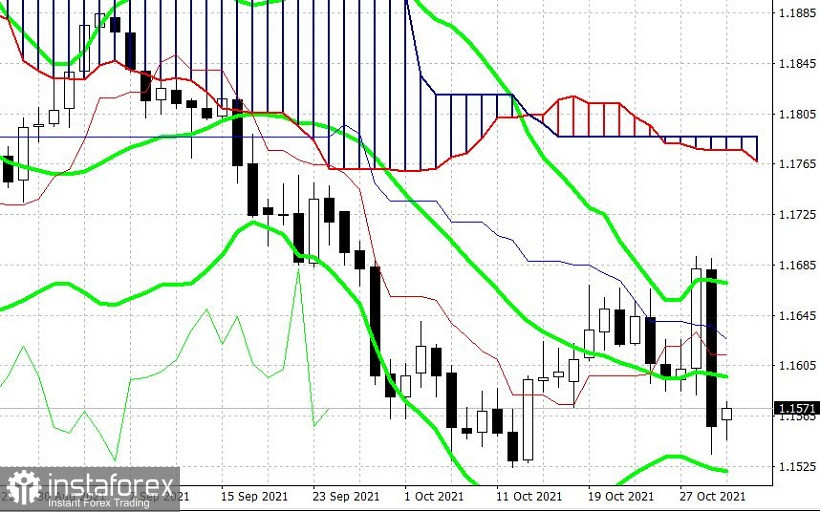The EUR/USD pair received a "bearish blow" last Friday, whose price declined by 160 points in just a few hours. If the buyers of this pair assaulted the borders of the 1.17 mark in the morning of Friday, then during the US session, sellers were already approaching the support level of 1.1520, which corresponds to the lower line of the Bollinger Bands indicator on the daily chart. This strong downward momentum was driven by several fundamental factors.
First off, it should be noted that the US currency took the lead, which sharply strengthened its positions throughout the market. In turn, the euro dutifully followed it, despite the recorded increase in Eurozone's inflation. Traders completely ignored Friday's release, which indicated that the general consumer price index in the eurozone soared to a 13-year high in annual terms. However, the results of the ECB meeting, announced before this release, previously neutralized the significance of this publication. Christine Lagarde denied rumors that the regulator could shift the timing of the rate hike in response to inflationary dynamics. According to her, the current trends are due to temporary factors that will fade as early as next year. At the same time, she admitted that the phase of inflationary growth "will last longer, than originally intended." This remark provided temporary support for the euro, literally for a few hours after the announcement of the results of the October meeting. However, the market came to a reasonable conclusion that the European Central Bank will not change its positions in the near future, and, therefore, the growth of inflation in the eurozone is decorative in the context of the prospects for the ECB's monetary policy.
It is worth noting that the current growth of the US dollar is also due to the release of the inflation data. The US dollar index increased last Friday after the publication of the Personal Consumption Expenditure Index (PCE). It is believed that this indicator is the most preferred for the members of the US regulator and is monitored by them "especially carefully". The core PCE index, which does not consider volatile food and energy prices, rose by 3.7% in September (in annual terms), remaining at the same level as it was released in August, July, and June. Experts predicted growth to 3.7%, but in this case, the "red zone" did not ruin the overall impression of the release.
It can be recalled that the US inflation growth for September also pleasantly surprised dollar bulls. The overall consumer price index in September accelerated to 5.4% yoy: at this level, the overall CPI was released in August and July, and before that, back in 2008. In monthly terms, the index also showed positive dynamics, rising to 0.4% (after a two-month decline). The core CPI, excluding volatile food and energy prices, came out at the level of forecasts: an increase of up to 0.2% was recorded in monthly terms, and up to 4.0% in annual terms.
Despite the rather contradictory Nonfarm data, all this suggests that the American regulator will maintain a "hawkish" attitude both in the context of curtailing QE and a possible rate hike next year.
The so-called "Friday factor", which coincided with the last trading day of the month, also played in favor of the US dollar. After EUR/USD buyers failed to enter the area of the 17th figure (not to mention it also failed to consolidate above the level of 1.1710 - the Tenkan-sen line on the weekly chart), traders "lost faith" in the prospects for further recovery. Market participants began to fix profits all at once, closing longs. As a result, the upward momentum faded, and the bears seized the initiative, especially amid the US dollar's general strengthening.
However, it is also necessary to talk about the prospects for the development of the downward trend with certain reservations. At the moment, the trading principle "buy on rumors" is in effect. This principle supports the US dollar "in advance": if the Fed members do not justify traders' hawkish hopes, then the second part of this principle "sell on facts" will be involved. So far, the US dollar is in demand, as traders are mostly confident that the regulator will have to respond to the ongoing inflationary growth. If the "hawkish" scenario is not implemented, the EUR/USD pair will return to the borders of the 1.17 level. However, it is too risky to play against the US dollar before the announcement of the results of the Fed's October meeting this Wednesday, since the pendulum may swing downwards any time.

From a technical point of view, the pair on the daily chart is located between the middle and lower lines of the Bollinger Bands indicator, as well as below all the lines of the Ichimoku indicator, which shows the bearish "Parade of Lines" signal. It is still possible to use corrective pullbacks to go short with the primary target of 1.1520 (lower Bollinger Bands on the same timeframe).






















